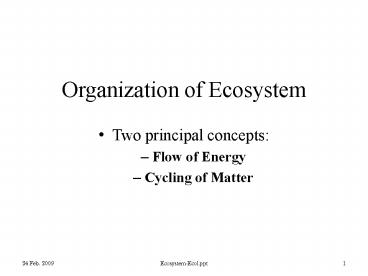Organization of Ecosystem - PowerPoint PPT Presentation
1 / 16
Title:
Organization of Ecosystem
Description:
Describe the relative portions of this energy reflected, used to ... Decomposer/detritivore. Trophic levels. Food web. Tertiary consumer (higher carnivores) ... – PowerPoint PPT presentation
Number of Views:21
Avg rating:3.0/5.0
Title: Organization of Ecosystem
1
Organization of Ecosystem
- Two principal concepts
- Flow of Energy
- Cycling of Matter
2
Energy Flow Cycling of Matter
3
Flow of Energy
- The earth receives about one one-billionth of the
of the suns energy output. Describe the
relative portions of this energy reflected, used
to power physical processes, and available for
living processes (lecture).
4
Solar Energy
- 28 reflected by atmosphere sea surface,
- 71 powers physical processes
- heating soil, air, water
- wind,
- ocean currents,
- evaporation, etc.
- lt 1 trapped by photosynthesis (available to
life).
5
Input to Ecosystem light E. via Photosynthesis
- CO2 H2O light ? sugar O2
- Occurs in plants, algae (producers)
- Energy (potential) stored in covalent bonds of
sugar molecules. - Movement (Flow) from organism to organism by
feeding.
6
Transfer of Energy by Aerobic Respiration
- C6H12O6 (sugar) O2 ? CO2 H2O energy (work
lost heat) - Occurs in animals (consumers, some detritivores)
- Occurs in bacteria, fungi (decomposers
detritivores)
7
Trophic levels
- Food chain
- Tertiary consumer (higher carnivores)
- Secondary consumers (carnivores)
- Primary consumers (herbivores)
- Producers (plant)
- Decomposer/detritivore
8
Trophic levels
- Food web
- Tertiary consumer (higher carnivores)
- Secondary consumers (carnivores)
- Primary consumers (herbivores)
- Producers (plants, algae, cyanobacteria)
- Decomposers/detritivores
9
Apply Laws of Thermodynamics
- 1. Energy can be transferred and transformed.
- 2. At transfer/transformation energy lost
- (low grade heat/infrared radiation to space).
10
Trophic levelsPyramid of Energy
- 10 J
- 100 J
- 1000 J
- 10,000 J
11
Trophic levelsPyramid of Numbers
- 10 tertiary consumers
- 130 secondary consumers
- 2000 primary consumers
- 50,00 producers
12
Trophic levelsPyramid of Biomass
- 25 g/ hectare
- 250 g/ hectare
- 2500 g/ hectare
- 25000 g/ hectare
- 4 kcal/gram biomass
13
Cycling of Matter
- Producers take up matter
- Photosynthesis
- CO2 from air H2O from water/soil ? glucose
O2 - Movement of matter through ecosystem
- Return of matter to inorganic form
- Aerobic respiration
- glucose O2 ? CO2 to air H2O to water/air
- Reservoirs/stores of matter
14
Carbon cycle
- Fluxes
- Photosynthesis
- Respiration decomposition
- Reservoirs
- Atmosphere
- Oceans
- Fossil fuels
- Carbonate rocks
15
Hydrologic cycle
- Fluxes
- Precipitation
- Evaporation
- Transpiration
- Reservoirs
- Atmosphere
- Oceans
- Groundwater
16
Nitrogen cycle
- Fluxes
- Nitrogen fixation
- Denitrification
- Weathering erosion
- Reservoirs
- Atmosphere
- Rock soil
- Organisms

